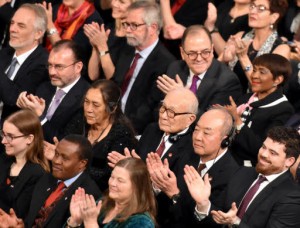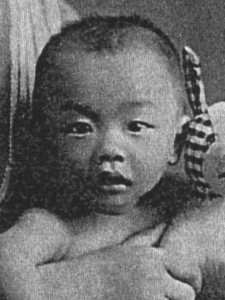Nuclear weapons ban treaty is now “light” for advancing nuclear abolition
Dec. 12, 2017
by Kyosuke Mizukawa, Staff Writer
Oslo, Norway – “Listen to our testimony. Heed our warning,” said Setsuko Thurlow, 85, in her speech at the award ceremony for this year’s Nobel Peace Prize on December 10 in Oslo. Ms. Thurlow, who is originally from Minami Ward, Hiroshima and now lives in Toronto, Canada, became the first A-bomb survivor to speak at a Nobel Peace Prize award ceremony. She spoke about the catastrophic conditions caused by the atomic bombing of Hiroshima, including the deaths of eight of her relatives and hundreds of schoolmates, and appealed to the entire world to take action to promote the nuclear weapons ban treaty, which she called a “light” for A-bomb survivors.
At around 1 p.m., a fanfare sounded at Oslo City Hall for the ceremony, which was attended by some 1,000 people. Ms. Thurlow came to the stage in a wheelchair and was wearing a Japanese-style dress made from a black kimono that had once been her mother’s and was kept in Hiroshima. Together with Beatrice Fihn, the executive director of the International Campaign to Abolish Nuclear Weapons (ICAN), she smiled as she received the Peace Prize medal. ICAN, a non-governmental organization (NGO), was award the Peace Prize for 2017.
But as Ms. Thurlow began her speech, the exultant look on her face quickly turned grim. “I want you to feel in this hall the presence of all those who perished in Hiroshima and Nagasaki,” she said. “Each person had a name.” Then citing the name of her four-year-old nephew, Eiji, who was killed by the atomic bomb, she continued, “His little body transformed into an unrecognizable melted chunk of flesh. He kept begging for water in a faint voice.” Ms. Thurlow’s testimony, which highlighted the inhumane consequences of the use of the atomic bomb, brought many attendees to tears.
Ms. Thurlow was 13 years old and a second-year student at Hiroshima Jogakuin Junior and Senior High School when the atomic bomb was dropped on Hiroshima. She was working as a mobilized student, about 1.8 kilometers from the hypocenter, at the time the bomb exploded. Although most of her classmates were burned to death, she somehow managed to crawl out from underneath the building that had collapsed on top of her, moving toward the light, and she survived. Based on that experience, she stressed, “Our light now is the nuclear ban treaty. Let us follow each other out of the dark night of nuclear terror.” She urged all nations to sign the treaty, and her words were met by resounding applause.
Akira Kawasaki, 49, a member of ICAN’s international steering committee, watched the historic speech from the front of the hall, hoping that Ms. Thurlow’s message, urging the whole world to work together for the abolition of nuclear weapons, will be conveyed to as many people as possible. Terumi Tanaka, 85, the co-chair of the Japan Confederation of A- and H-Bomb Sufferers Organizations (Nihon Hidankyo), which was established 61 years ago, was invited to the award ceremony with Toshiki Fujimori, the assistant secretary general of the organization. He shares the same feelings as Ms. Thurlow, who was representing all the A-bomb survivors. Mr. Tanaka said, “With the incredible efforts of the A-bomb survivors, the nuclear weapons ban treaty has been realized and our movement is now seen in a very positive light. But this is just the first step on the road to achieving our dream of a world without nuclear weapons.”
After the award ceremony, Ms. Thurlow was interviewed by the press and spoke calmly, saying, “Because the audience listened closely to my speech, and responded to it very positively, I feel a great sense of satisfaction and accomplishment.” She added, “We have a duty to press all nations to ratify the treaty, rather than leaving this up to hope alone, and ensure that the treaty will actually enter in force.” And she expressed the expectation that the awarding of the Nobel Peace Prize to ICAN will inspire civil society to make further efforts to advance the abolition of nuclear weapons.
(Originally published on December 12, 2017)
Oslo, Norway – “Listen to our testimony. Heed our warning,” said Setsuko Thurlow, 85, in her speech at the award ceremony for this year’s Nobel Peace Prize on December 10 in Oslo. Ms. Thurlow, who is originally from Minami Ward, Hiroshima and now lives in Toronto, Canada, became the first A-bomb survivor to speak at a Nobel Peace Prize award ceremony. She spoke about the catastrophic conditions caused by the atomic bombing of Hiroshima, including the deaths of eight of her relatives and hundreds of schoolmates, and appealed to the entire world to take action to promote the nuclear weapons ban treaty, which she called a “light” for A-bomb survivors.
At around 1 p.m., a fanfare sounded at Oslo City Hall for the ceremony, which was attended by some 1,000 people. Ms. Thurlow came to the stage in a wheelchair and was wearing a Japanese-style dress made from a black kimono that had once been her mother’s and was kept in Hiroshima. Together with Beatrice Fihn, the executive director of the International Campaign to Abolish Nuclear Weapons (ICAN), she smiled as she received the Peace Prize medal. ICAN, a non-governmental organization (NGO), was award the Peace Prize for 2017.
But as Ms. Thurlow began her speech, the exultant look on her face quickly turned grim. “I want you to feel in this hall the presence of all those who perished in Hiroshima and Nagasaki,” she said. “Each person had a name.” Then citing the name of her four-year-old nephew, Eiji, who was killed by the atomic bomb, she continued, “His little body transformed into an unrecognizable melted chunk of flesh. He kept begging for water in a faint voice.” Ms. Thurlow’s testimony, which highlighted the inhumane consequences of the use of the atomic bomb, brought many attendees to tears.
Ms. Thurlow was 13 years old and a second-year student at Hiroshima Jogakuin Junior and Senior High School when the atomic bomb was dropped on Hiroshima. She was working as a mobilized student, about 1.8 kilometers from the hypocenter, at the time the bomb exploded. Although most of her classmates were burned to death, she somehow managed to crawl out from underneath the building that had collapsed on top of her, moving toward the light, and she survived. Based on that experience, she stressed, “Our light now is the nuclear ban treaty. Let us follow each other out of the dark night of nuclear terror.” She urged all nations to sign the treaty, and her words were met by resounding applause.
Akira Kawasaki, 49, a member of ICAN’s international steering committee, watched the historic speech from the front of the hall, hoping that Ms. Thurlow’s message, urging the whole world to work together for the abolition of nuclear weapons, will be conveyed to as many people as possible. Terumi Tanaka, 85, the co-chair of the Japan Confederation of A- and H-Bomb Sufferers Organizations (Nihon Hidankyo), which was established 61 years ago, was invited to the award ceremony with Toshiki Fujimori, the assistant secretary general of the organization. He shares the same feelings as Ms. Thurlow, who was representing all the A-bomb survivors. Mr. Tanaka said, “With the incredible efforts of the A-bomb survivors, the nuclear weapons ban treaty has been realized and our movement is now seen in a very positive light. But this is just the first step on the road to achieving our dream of a world without nuclear weapons.”
After the award ceremony, Ms. Thurlow was interviewed by the press and spoke calmly, saying, “Because the audience listened closely to my speech, and responded to it very positively, I feel a great sense of satisfaction and accomplishment.” She added, “We have a duty to press all nations to ratify the treaty, rather than leaving this up to hope alone, and ensure that the treaty will actually enter in force.” And she expressed the expectation that the awarding of the Nobel Peace Prize to ICAN will inspire civil society to make further efforts to advance the abolition of nuclear weapons.
(Originally published on December 12, 2017)









